- Plant description
- Useful properties
- Application of barley grains
Groats barley has a rich set of useful properties and substances needed by the body. This is one of the oldest cereal plants cultivated by man. It is used in cooking, forage and technical purposes, as well as in the brewing industry.

Description of the plant
Under the name Barley, a whole genus of cereal plants hides, however, barley is common for food purposes. Other representatives of this genus are rarely cultivated, they often grow wild. Varieties of barley refer to annual, biennial and perennial grasses.
Barley, along with wheat, is considered one of the earliest cereal plants that a man began to cultivate and consume. It happened in the Middle East at least 10 thousand years ago. He is pleased with a large range of habitats - from the island of Crete and the northern coast of Africa to the Tibetan mountains.
Archaeological finds confirm the widespread spread of barley as a cereal crop, not only in Asia, but also in Egypt of the times of the pharaohs, ancient Greece and the Roman Empire. Cultivated it and in the northern countries - Norway, Finland.Useful properties of
Groats of barley are the grains of an annual plant. Because of its unpretentiousness, barley groats were considered cheap and unprofitable, so in the Middle Ages it was replaced by more expensive wheat. And although barley has huge useful properties, porridge from it has lost popularity, began to be considered a fodder product, affordable peasant dish.
Porridge cooked from barley preserves almost all the useful properties of this cereal, as the grains are subjected to minimal processing. Therefore, it is rich in fiber, ahead of its number even oatmeal, which is considered the recognized leader in this matter.
A soluble variety of fiber can significantly improve the general condition of the body, reduce the cholesterol and blood sugar. These properties make grains of barley grains very useful for those who are prone to rapid weight gain and seek to normalize it.
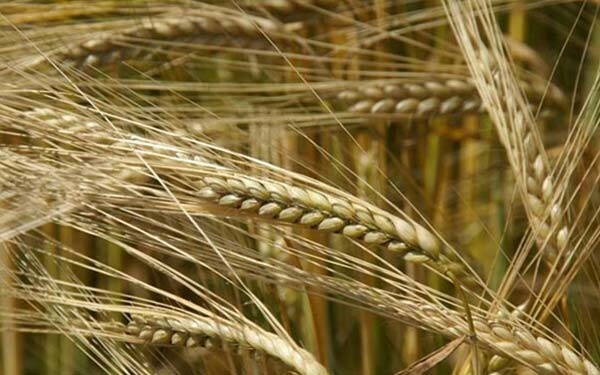
The composition of barley is very harmoniously balanced, it contains many vegetable proteins, carbohydrates, vitamins E, PP, B4 and B6, as well as microelements:
- potassium;
- calcium;
- iron;
- iodine;
- phosphorus;
- copper;
- chrome;
- manganese;
- zinc.
Such a rich composition provides the barley with the highest nutritional value among other food cereals - 324 kcal per 100 grams.
Carbohydrates, which are part of barley seeds, refer to the so-called long carbohydrates, which fully saturate the body and give a feeling of satiety for a long time. They are digested for a long time, so do not cause a sharp increase in blood glucose, so barley is useful to include in the medical or diet menu for diabetes, significant physical exertion.
Microelements contained in barley, bring much benefit to the body as a whole, strengthening the bones and blood vessels, participating in the process of hematopoiesis. Also in the composition of the grains is lysine - it is an amino acid, available to humans only from plant foods. Among its properties is stimulation of the production of its own collagen and support of the immune system.
Barley broth has significant enveloping properties, which makes it very useful for various gastrointestinal diseases characterized by irritation of the mucous membrane. It also exerts a restorative, tonic effect on the body, especially necessary during the recovery from severe illnesses.
Contraindications
Barley in any form is beneficial to the body, but in some cases it can cause harm. Contraindications to its use are diseases of the gastrointestinal tract in acute stage.
Although barley dishes contribute to weight loss, abuse of them can cause the opposite effect - a rapid weight gain. Therefore, it is better to include barley in the menu approximately 1-2 times a week.
Important! Barley contains up to 22.5% gluten, so it should be excluded from the menu for those who suffer from intolerance to this substance or celiac disease.
Application of barley grains
Barley grains are gradually gaining popularity among those who follow their diet and health. Although most people perceive barley as a product for cooking porridge, you should know that barley is also made from malt, decoctions, coffee beverage.
Barley porridge
What kind of barley is made from barley? Surprisingly, two grains of cereal are made from the grains of this cereal - barley and pearl. The difference lies in the way the grain is processed, which affects the useful properties of the resulting cereal.
Barley cereals
Porridge from crushed barley, usually called barley. In this case, the grains are not polished, only broken into small pieces. Due to this, they retain the bulk of the fiber. In this case, the porridge of the egg turns out to be softer than the barley, so it is suitable for children's and dietary rations. Another advantage is the lower cost.
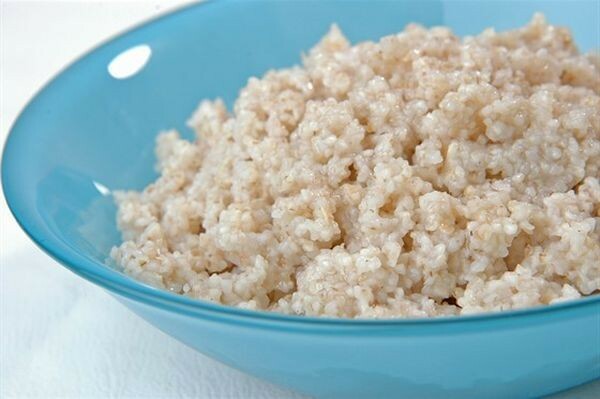
The useful properties of barley cereal include:
- ability to alleviate allergic reactions;
- enveloping effect, useful in diseases of the digestive tract;
- anti-inflammatory, diuretic properties;
- is the largest among other cereals content of plant fiber, which promotes maximum absorption of nutrients and a long feeling of satiety.
There is a lot of protein-containing gluten in the barley groats, as well as the necessary amino acids.
Pearl barley
Pearl barley is ground whole grains of barley. They are divided into a large and a small fraction. The small barley is digested a little easier, it boils faster. It is used for cooking soups, cereals, cooking cutlets and casseroles. From a large pearl barley, too, porridges are cooked, but more crumbly, necessarily pre-soaked croup for several hours in cold water.
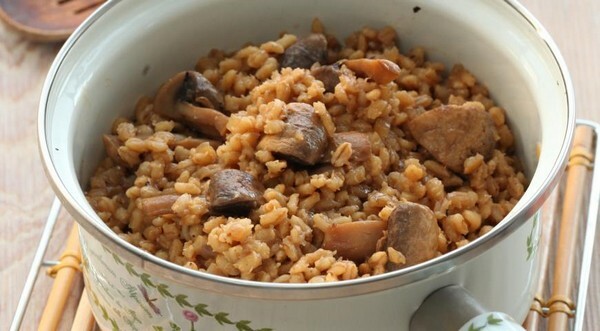
Perl porridge in its useful properties is very similar to barley. Their main difference is the way of processing, as a result of which the perlovka loses some of the fiber.
The classic recipe for barley porridge
You can prepare barley porridge in many ways. Pearl barley usually brews from 1 to 2 hours, barley is only 40-45 minutes. Correctly cooked porridge will surprise with its rich taste and for a long time will become one of the loved ones in the family.
- Groats need to be washed in cool water to remove mote and dust.
- To make the porridge from the barley faster, and the grains are softer, the croup is pre-soaked for several hours. Ideally, it is left in the water for the whole night, keeping the proportion - for 1 cup of cereals take a liter of cold water.
- Barley groats are perfectly supplemented with milk, so after soaking it is poured with 2 glasses of milk for crumbly porridge and 4 for viscous milk. In the classic recipe, the porridge was left to languish in a water bath for 6 hours. Using the multivark, you can reduce this process to 40 minutes.
- Cooked cereal should be filled with butter. Barley loves it very much, the more oil is added to the porridge, the brighter its taste will be. This is the very case when "you can not spoil the porridge with oil."
Barley porridge on the water fits well with mushrooms, meat, cracklings, fish or vegetables. Most spices and fresh herbs are suitable for it.
Barley malt
Brewing barley is subject to certain requirements, both to external characteristics and to its technological properties. The first group includes the following indicators:
- barley, from which malt for beer will be made, should have a uniform light yellow or yellow color. Green color indicates the immaturity of the grain, and the dark yellow, with impregnations of black or brown - about improper storage. It is most likely that such barley was soaked or struck by microorganisms, because of which it lost its germination and malt qualities;
- in the smell of quality barley should not be impurities of rot or mold. As a rule, it is rather fresh, a bit like the smell of straw. To hear it, you need to heat a few grains in the palm of your hand, and then - grind them;
- grain purity is determined by the absence of impurities( damaged or diseased grains, other grains, weed grass, etc.) and pests.
Technological characteristics include germination, moisture and protein content, and extractivity - the amount of substances that enter the solution as a result of processing.
You can make malt from barley at home. Sprouted barley can be used as a nutritional supplement or as a raw material for cooking home beers.
First of all you need to check the purchased cereals for germination. For this, about a hundred of the largest grains are selected from the total mass and filled with a glass of water. Pop-up copies are replaced with new ones until everyone drowns. Then the barley is laid on the cloth, covered with moist gauze and left for 2-4 days in the heat. After that you need to calculate how many grains have not germinated. Each will be equivalent to one percent. If the total germination has turned out to be more than 90%, then the raw material is well suited for making malt.
For the preparation of malt, it is important to thoroughly wash the barley and separate all the surfaced grains, as well as dirt and impurities. Then the remaining raw material is poured with water 5 cm above the grain level and left for 14 hours. In this case, after 7 hours, the water should be replaced with fresh water. In the end, you can disinfect the grain, fill it with a weak solution of potassium permanganate for 1-2 hours.
After decontaminating the barley, spread the grains in a thin layer( 4-5 cm) on the pallets, as in the photo below:
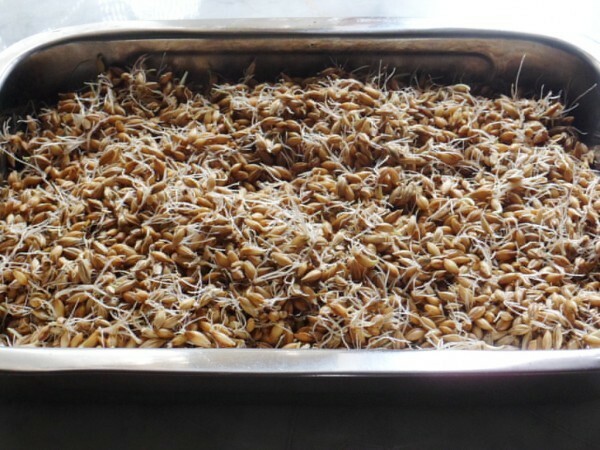
They need to be mixed every 2-3 hours. After a day, cover it with a damp cloth and leave it in a warm room( 15-20 degrees).The seeds are mixed and moistened every day. Malt is ready when the sprouts reach a size equal to 1.5 times the length of the grain. The period of storage is 3 days. You can increase it by drying the malt.
Before drying, it is again treated with a solution of potassium permanganate( for 1 liter of water - 0.3 g of manganese) for 20 minutes. Then the malt is dried at a temperature of no higher than 30-40 degrees. For this purpose, a well-ventilated attic is suitable, or a warm room in which the fan operates. Drying takes 3-4 days, after which the seeds are removed by sprouts, rubbing them between the palms, and sent to storage in linen bags.Coffee drink
A very delicious coffee drink is obtained from fried and ground barley and rye grains. It can serve as a complete replacement of coffee in cases where caffeine is contraindicated. This drink is very useful, since it preserves most of the properties of barley and rye.
It can be used to improve digestion, weight loss, diabetes prevention and general health improvement. In this case, barley coffee, unlike the usual, does not contain caffeine, so it does not excite the nervous system. Thanks to this, it can be drunk at any time of the day and at any age.
The coffee drink from barley has no contraindications, it can be consumed even during pregnancy and lactation, if there is no individual intolerance.
Prepare such a drink at home is not difficult. To do this, fry the grains of barley and rye on a hot dry frying pan, then grind. From the resulting powder, you can brew coffee according to the following recipe:
- 1 tbsp.l.powder;
- 150 ml of water.
The powder is poured into the turkey, poured into water and boiled for 2 minutes, after which it is allowed to stand under the lid for the same amount. To get a more intense color, you can add half a teaspoon of ground chicory to the coffee blend.
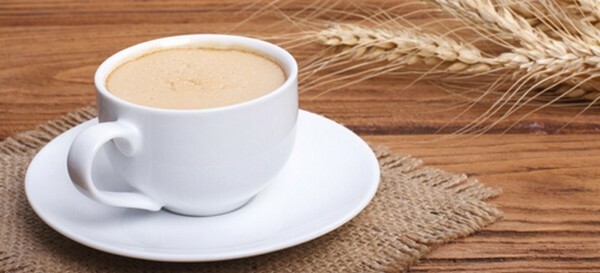
It's interesting! As already mentioned, barley is perfectly combined with milk, so the water in the recipe can be replaced by a third with milk or add it to the ready-made drink. It will decorate the taste and make it softer.
In the finished coffee, cream, honey or sugar is also added to taste.
Despite unfair oblivion, barley grains gradually restore their place in cooking. Its useful properties and rich composition make this herb one of the most valuable plants for nutrition, which must be included in the diet not only for treatment, but also for the prevention of many health problems.
